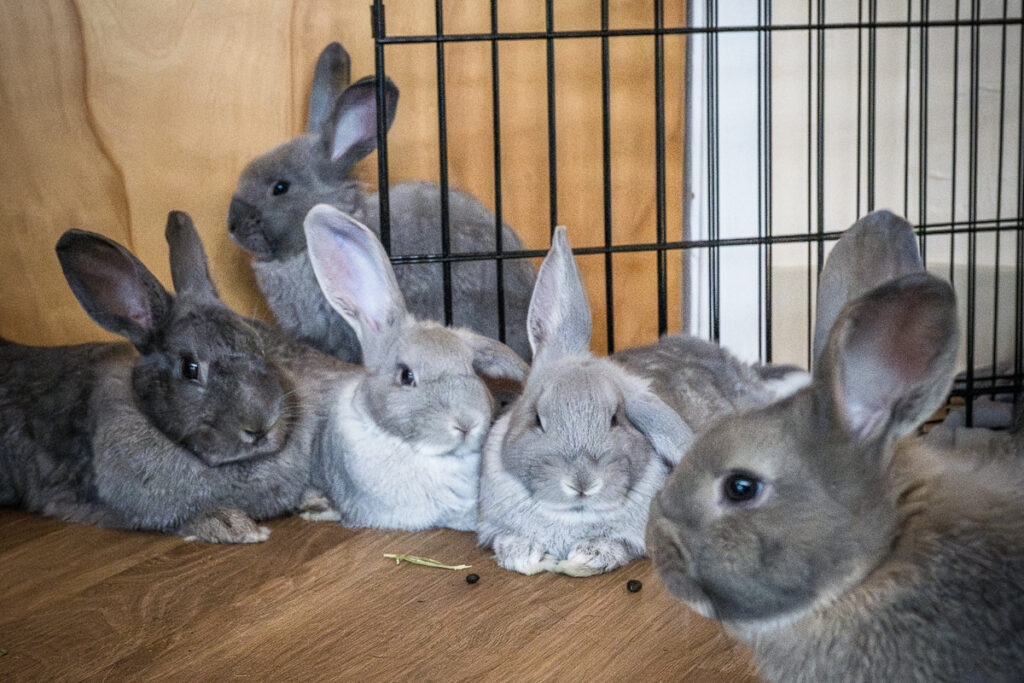A call comes in about a rabbit breeder who just skipped town, leaving 80 rabbits with no one to care for them. Or you heard on the news about a collector whose 150 rabbits were just confiscated by Animal Control, overtaxing the shelter’s resources and leading to probably wide-scale euthanasia. Multi-rabbit abandonment. Hoarding. Abuse. Other rabbit rescue volunteers and I have assisted in many large-scale rescue situations.
How do you handle such a situation?
If you want to facilitate a large rabbit rescue, here are some tips. They are broken down into two main scenarios, based on who will be housing and caring for the rabbits.
Scenario One: Your Organization Houses the Rabbits
- Contact the authorities. Your local animal control agency will be the first organization to contact, if they haven’t already been involved, as they will have the legal ability to gain access to a private property.
- Learn the local law. If the police or animal control won’t seize the animals, you may look at neighborhood code enforcement or even public health/safety regulations as a way to get the community to take action.
- Get press when warranted. The more the public knows about the situation, the more help they can offer. Members of the public can provide assistance by coming into the shelter to care for the seized animals, by providing food, by making donations so that supplies can be purchased, and by adopting animals when the time is right. However, you may need to wait to get the press involved until after all the rabbits are out of the original situation. When Orange County HRS did a large rescue many years ago, even though it was on private property, once the press mentioned where the rabbits were, all kinds of people were out there taking rabbits. On the other hand, letting the public know through the press could be a way to marshall public support as well.
- Create a social media presence. Use social media such as Instagram, GoFundMe, Facebook, TikTok, etc. to share information that is constantly updated about the situation, and email your supporters as well with updates.
- Photograph all the rabbits and name them. Keep in mind that the photos you include will either prompt donations (neglected, sick or injured rabbits) or will promote adoptions (well groomed, clean, healthy looking rabbits). Before and after pictures are recommended.
- Create a wish list. Ask the public to donate food, hay, toys, rescue supplies and housing through Amazon, Chewy, Oxbow, Small Pet Select, etc.
- Request volunteers for grooming. Many of the rabbits may be ill-groomed; having volunteers come into the shelter to provide brushing, combing, mat-removal and flea-control services would help to make the rabbits more adoptable.
- Contact veterinarians or the local veterinary school. You’ll need assistance with spays and neuters, as well as check-ups and basic health care, to all of the rabbits. Veterinarians will also be invaluable in providing expert testimony should you or the authorities succeed in getting a cruelty or abuse case charged.
- Keep a paper trail. Learn the intake paper work of whoever is housing the rabbits (ie animal control, etc.) and have your own paperwork in the holder with the shelter’s intake papers. Recommended items to add: description, any obvious medial conditions, sex, personality (which can be added to as volunteers get to know the rabbits). A sheet should be provided so each day whoever cleans and exercises the rabbit signs date and what was done. Paperwork is essential and your paperwork added to the shelters is invaluable.
- Look out for and address compassion fatigue. Volunteers helping with such large rescues may feel overwhelmed with the work and responsibility. Schedule small meetings and get-togethers to assess the mental health of your volunteers and to make sure everyone is okay.
- Work with other local rescues. Contact other local rescue groups for assistance with providing temporary foster care for the rabbits. Even non-rabbit rescue organizations can possibly help.
- Involve social services. If it’s the case of a senior citizen/collector, adult protective services/senior care groups have expertise in dealing with the additional problems that older pet owners may have.
- Keep communication lines open with law enforcement. Once the case has moved from the police or animal control to the District Attorney’s office, keep in contact with the DA to ensure that they are taking the case seriously. Continue to send out press releases and have your members, volunteers and the public send letters to the DA’s office.
- Consider a triage center. If you will be receiving the rabbits, and not your local animal control or humane society, and there are a great many rabbits to handle, you may want to plan for delivery of the rabbits “after hours” and set up a “triage center” at your vet’s office. If your veterinarian will donate space such as in the parking lot and some assistance (vet or vet technicians) to identify health needs, ID or number and sex the rabbits (permanent marker in the ear), once that is done, you can pass the rabbits along to shelters or volunteers for fostering.
- Consider a spay/neuter release program. If the rabbits are a group of free-living stray or feral rabbits, you may also need to consider a spay/neuter release program. If there are too many rabbits to be rescued and re-homed, and/or if the local shelters and foster groups don’t have the resources to adequately help with this, you can contact veterinarians for help with spaying, neutering, and tagging (ie ear notching or ear-hole punching) the rabbits, and re-releasing them into the area they were caught in, assuming that it is relatively safe from predators, cars, or angry homeowners.
Scenario Two: Shelter or Animal Control Houses the Rabbits
These ideas and suggestions are with regard to a shelter keeping most of the confiscated rabbits:
- Encourage the shelter to house the rabbits if your volunteers can help with cleaning, feeding and general care. Your group should also be prepared to assist when the rabbits become available for fixing and adoption. Be sure to have the rabbits sexed (and palpated for pregnancies) and the rabbits housed separately by sex! Create a plan for dealing with any detected pregnancies.
- Issue a plea for volunteers to help with the newly confiscated rabbits. Explain the problem, specifically what they will be doing and find out their dates & times available.
- See if your volunteers will need to complete any shelter classes or get permission to enter the shelter for the specific task of caring for these rabbits.
- Find out the status of the rabbits. This is very important. Were they relinquished to the shelter? Stilled owned? Is a criminal case pending? Are they available for adoption now? If not, when? Are you allowed to fix or treat the rabbits?
- Once you have your volunteers in place, hold an orientation for them so they know where all the supplies are kept, where they are allowed to go in the shelter, who they should report problems to and your specific directions regarding the rabbits. Provide a hand out with this info.
- Take photos before, during and after. This could be very important for any case the shelter is developing. It will also be helpful for the HRS chapter in promoting and reporting on the situation as well as monitoring the health of certain rabbits.
- Send a memo to the Shelter Director and anyone else as appropriate. Include what your volunteers agree to do such as: daily feeding, supplying hay bales and other supplies, pay for spay/neuter when rabbits are available, assist with adoptions when available, etc.
- Also, outline what the shelter will agree to do, such as not put to sleep a rabbit without notifying with you first, allow a (non-shelter) vet on site to examine rabbits if necessary, allow adoption days, contact media, etc.
- Press Releases. If the case is a large neglect case for example, you may be able to get exposure, volunteers and donations through your local media. Often times Animal Control will have a stronger relationship with the media than the local rabbit rescue. Decide who should issue a press release. Provide the interviewer with good questions to ask you. Also, tell the audience what you need (if anything) and how they can donate. When you have a happy adoption or other good news about the rabbits, invite the media back for a follow up story.
- If there are more than a couple of rabbits who need veterinary attention (and the shelter vet is not rabbit savvy), see if you can get a local rabbit vet to make a shelter visit instead of bringing all the rabbits into the vet. Take photos of this nice vet for a thank you at a later date!
- Once fixed, healthy and available for adoption, hold shelter adoption days where volunteers can help the staff with adoptions.
- Take some rabbits into foster care as space is available.
- Update your website with details of the rescue and your involvement in the case.
Notes For Setting Up Rabbit Rooms At Your Shelter and Rabbit Volunteers
- Set up the volunteer schedule. Use Yahoogroups or another avenue to create a Volunteer List. This way, volunteers can communicate easily.
- Provide a notebook for medical/other notes
- Provide cage cards with important info on them for each rabbit including RED stickers for those needing meds every day. With this, volunteers are less likely to forget somebunny.
- Isolate sick rabbits from the others as much as possible. Make sure all volunteers know to take sanitary precautions between handling rabbits.
- As needed and as room permits, bring extra hay and secure hay containers, litter, table for giving meds or grooming, nail clippers & brushes, hand sanitizer, litter boxes, bowls, newspaper, pellets, toys, portable cooler and ice for veggies, cages, towels, exercise pens, writing pens and dry erase board to post daily notes to volunteers.
- If needed and if there is space, see if a local home improvement store will donate an awning to allow for exercise or additional space.

